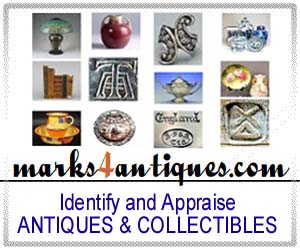APPRAISALS & ANTIQUES VALUES
Part I - Some Definitions
To find prices and determine values for your antiques & collectibles of any kind, please see our Price Guides with millions of examples of sold items.

According to Webster’s College Dictionary, an Appraisal is “(a) The act of estimating or judging the nature or value of something or someone, (b) a valuation, as for sale or taxation, (c) an estimate or considered opinion.”
If you're a fan of Antiques & Collectibles, you know that the topic is far more complex than a simple definition can capture. It's not just about having a vague idea of "value," there are precise terms like "Fair Market Value," "Replacement Cost," and "Insurance Value" that require consideration. And as you delve deeper, questions arise - is the price you paid on eBay equivalent to an official Appraisal? Can you insure a Collectible you keep at home for the same price you paid the dealer? And what if your grandmother purchased the item 60 years ago, how should you determine its worth?
So, hold on tight because we're about to take you on a dizzying journey into the intricacies of appraisals. You'll learn about the IRS's take on it, what your Divorce Lawyer might have in mind, and how you as an eBay dealer (or any online seller) can determine what price to list your items at. Get ready to explore the depths of this fascinating and complex world of Antiques & Collectibles.
The International Society of Appraisers (ISA), teaches us that an Appraisal “is the act or process of developing an opinion of value, cost, or present worth of forecasted earnings; a written report documenting the same; of or pertaining to appraising and related functions”. Well, that’s much better, at least we have an expanded definition that refers to actual values AND costs AND future income potential. However, for most antiques & collectibles dealers, what seems to be the key term here is the word “value”, not only in as much as to how it is obtained (the process of Appraisal) but also for what purpose.
Let’s start with some definitions of “Value”:
Market Value: Refers to the most likely price that a Buyer will pay a Seller for a particular item within a specific market environment and at a specific point of time. This is the most common usage of this term as used for the value of an Antique or Collectible and strictly depends on the sales venue and time of the sale. In other words, it is the price that an item fetches when sold, say at a Flea Market or on Rubylane on such and such a date – period! An experienced Antiques Dealer immediately knows that this Market Value also depends on the knowledge of the Buyer, or the Seller for that matter. In other words, if the Seller does not know that a particular Royal Worcester Figurine is very rare, s/he could sell it at a very low price, but this is still the “Market Value”. This is NOT an official Appraisal Value and has little legal weight. However, this is the value that is used as guidance for most dealers when pricing their items for sale.
Fair Market Value: This is similar to “Market Value” as defined above, BUT with the understanding that the item is sold “in fairness”. In other words, in this situation, both the Seller and the Buyer “know” what the item is (maker, age, condition, provenance etc) and what it is most probably worth at a given period of time regardless of whether a sale happens or not. In such cases, neither the Seller nor the Buyer has any advantage, for example, knowledge of any damage that has not been communicated to the other or some special conditions that may affect its price: all information is openly shared and a potential transaction would take place in full honesty. This is the type of Appraisal Values sought in Real Estate Appraisals, such as for a home. IRS also seems to go by this definition, although there are numerous other conditions and “small print” loopholes that may affect the Taxed or Deductible value depending on whether it is for Estate Tax or Donation or Gift etc. But, most importantly and for our purposes, this is the most common type of Value used in formal Appraisals of Antiques & Collectibles.

Other terms include:
Actual Cash Value: [aka “actual value” or “cash value”] Used mostly by Insurance companies and refers to the money or
settlement paid to a Claimant in case of loss. This can vary depending on whether an item can be replaced by purchasing an identical item available in the market or it
is unique, such as a very old heirloom no longer made or sold, and cannot be readily replaced. The first instance is easy to determine; the latter requires a formal
Appraisal. Additionally, in most Insurance cases, there are also other factors to consider, for example, Depreciation, Functionality, ability to fully repair and
restore the item etc.
Marketable Value: Refers to the net amount after all costs necessary in a sale have been subtracted. Such sales costs may be Sales Commissions, Auction
Commissions, Advertising Costs, Appraisal Costs etc.
Net Value: Similar to Marketable Value but less any liens or debts associated with the item or property. This is the value used most often during
Divorce Proceedings.
Value in Use or Value in Place: Refers to the amount of money a particular item may contribute to its owner because of its use in a certain place or
environment. For example, certain equipment or tools that are essential for the success of a business or one’s profession fall in this category. In a broader
sense, this value also covers any sentimental worth attached to the item by the owner, which can be highly subjective, but often plays a huge role when dividing
property during a divorce or amongst heirs.
So, how does one go about getting an Appraisal? And when should one seek such advice? On that topic, please see our What is an Appraisal Part II article where we explore several methods that can be cost effective for most antiques dealers and collectors.
Unlock the true value
of your collection with our comprehensive research guides from identifying makers' marks to appraising all kinds of
antiques and collectibles.
Our up-to-date information will give you an accurate understanding of your items' worth. Don't miss out on this
valuable resource - visit our research tools today!
Search our price guide for your
own treasures.





